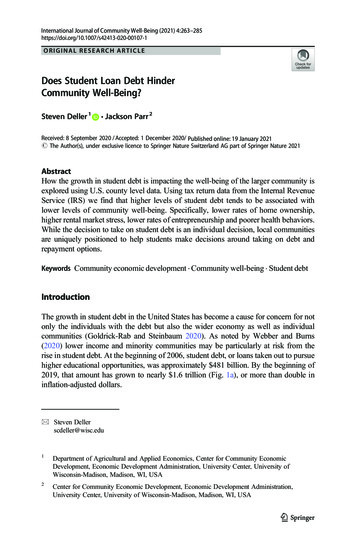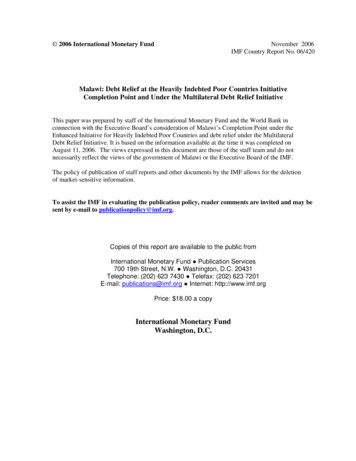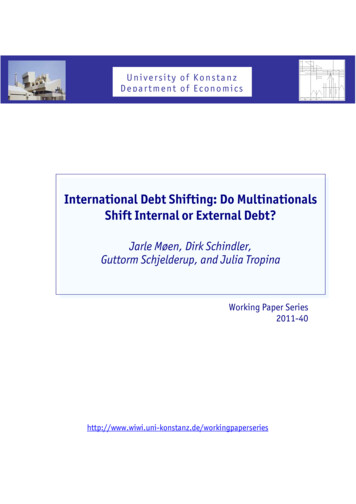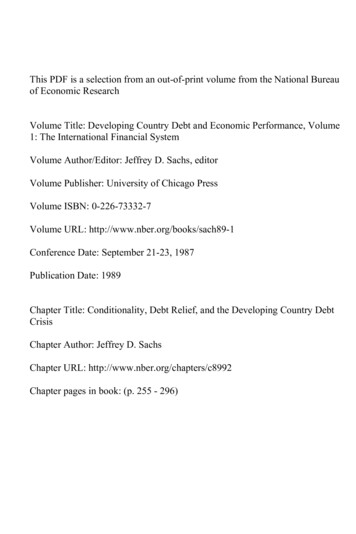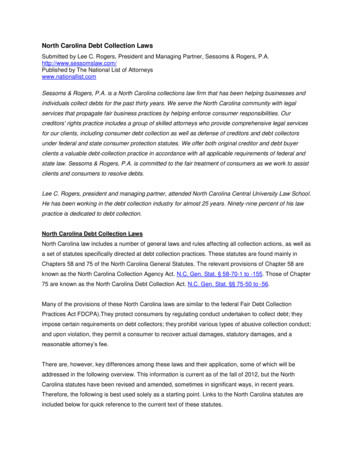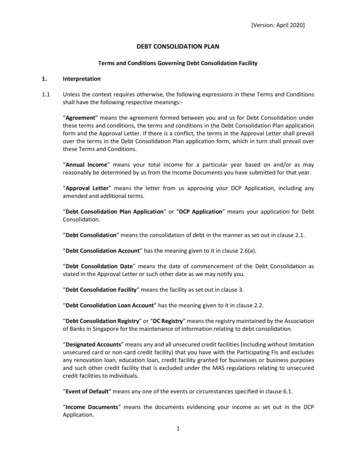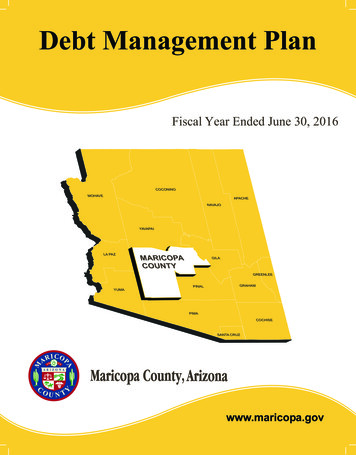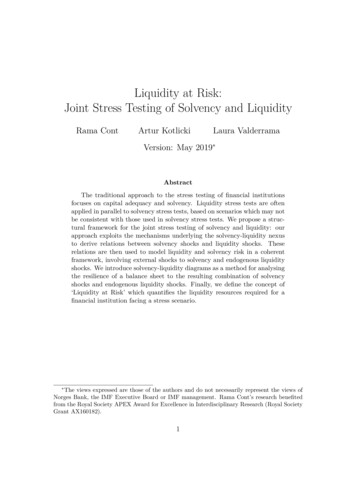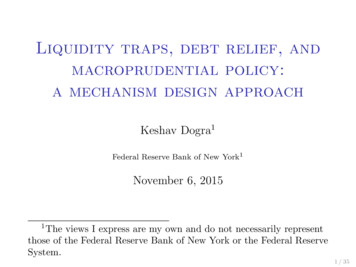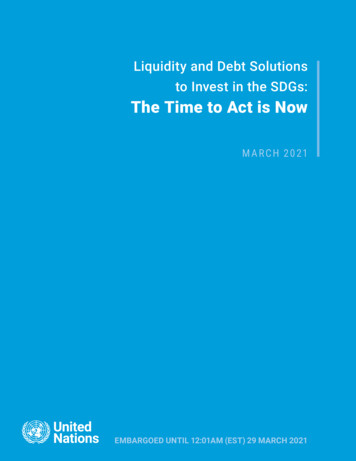
Transcription
Liquidity and Debt Solutionsto Invest in the SDGs:The Time to Act is NowMARCH 2021EMBARGOED UNTIL 12:01AM (EST) 29 MARCH 2021
CONTENTSINTRODUCTION. . . . . . . . . . . . . . . . . . . . . . . . . . . . . . . . . . . . . . . . . . . . . .3One year into the crisis: a stocktaking. . . . . . . . . . . . . . . . . . . . . . . . . . . . . . . .3SDG INVESTMENTS FOR RESPONSE AND RECOVERY. . . . . . . . . . . . . . . . . . . . .6Provision of fresh financing. . . . . . . . . . . . . . . . . . . . . . . . . . . . . . . . . . . . . .6LIQUIDITY SUPPORT. . . . . . . . . . . . . . . . . . . . . . . . . . . . . . . . . . . . . . . . . . .8A new general allocation of SDRs. . . . . . . . . . . . . . . . . . . . . . . . . . . . . . . . . .9Extension of the debt service suspension. . . . . . . . . . . . . . . . . . . . . . . . . . . . . 10DEBT RELIEF AND THE COMMON FRAMEWORK. . . . . . . . . . . . . . . . . . . . . . . . . 11THE INTERNATIONAL DEBT ARCHITECTURE. . . . . . . . . . . . . . . . . . . . . . . . . . . 13Strengthened architecture through principles. . . . . . . . . . . . . . . . . . . . . . . . . . . 13Building on existing initiatives. . . . . . . . . . . . . . . . . . . . . . . . . . . . . . . . . . . . 14CONCLUSIONS AND CALL FOR ACTION. . . . . . . . . . . . . . . . . . . . . . . . . . . . . . 172LIQUIDIT Y AND DEBT SOLUTIONS TO INVEST IN THE SDGS: THE TIME TO ACT IS NOW E M BA R G O E D U N T I L 12:01A M (E S T ) 29 M A R C H 2 0 21MARCH 2021
Introduction1COVID-19 has caused an extraordinaryand iii) addressing structural deficiencies ofsocio-economic crisis throughout the world.the international sovereign debt architectureMore than a year into the pandemic, the worldto prevent defaults from leading to prolongedis still in firefighting mode. But long-term eco-financial and economic crises in the future.nomic scarring effects and an uneven recovery,potentially leading to a sharply diverging world,are increasingly coming into focus. The severefiscal impacts of the crisis are triggering debtdistress in a growing number of countries andseverely limit the ability of many countriesto invest in recovery, climate action, and theThe international community’s response wassignificant, but not sufficient. Initial measuresincluded monetary easing, access to freshconcessional financing, a suspension ofdebt service payments on bilateral debts,and targeted but limited relief on somesustainable development goals (SDGs).multilateral debt. More action is needed.Such fiscal impacts, along with the rise ofThe purpose of this policy brief is to takevaccine nationalism, have also resulted indeveloping countries facing enormous difficulties in accessing vaccines against COVID19,which threatens to prolong the recoveryperiod. Unless we take decisive action onstock of the global policy response sinceApril 2020, assess remaining gaps and challenges for their implementation, and proposeupdates to the original recommendations inlight of developments over the last year.debt and liquidity challenges, we risk another‘lost decade’ for many developing countries,putting the achievement of the SDGs by the2030 deadline definitively out of reach.ONE YEAR INTO THECRISIS: A STOCKTAKINGIn my April 2020 policy brief on debt, I proposeda three-pronged approach to address impendingOver the last 12 months, countries have takendebt and liquidity issues caused by the pandemicunprecedented policy actions to control thein developing countries: i) a debt standstillspread of the deadly virus and mitigate itsto provide immediate breathing space for allsocioeconomic impact. To reduce pressure oncountries that need it; ii) additional, targetedoverwhelmed health systems, governmentsdebt relief for countries that require supportimposed exceptional social distancing poli-beyond a temporary suspension of debt service;cies, including lockdowns, business closures2and travel bans. These emergency policies1This Policy Brief draws on the Financing for Sustainable Development Report 2021 of the Interagency Task Force on Financing forDevelopment as well as Kharas, H. and Dooley, M. (2021). Debt Distress and Development Distress: Twin crises of 2021. Working Paper153. Washington, D.C.: Brookings, 35 pp.2United Nations, ‘Debt and COVID-19: A Global Response in Solidarity,’ Executive Office of the Secretary-General (EOSG) Policy Briefs andPapers No. 4, https://doi.org/10.18356/5bd43e89-en.3LIQUIDIT Y AND DEBT SOLUTIONS TO INVEST IN THE SDGS: THE TIME TO ACT IS NOW E M BA R G O E D U N T I L 12:01A M (E S T ) 29 M A R C H 2 0 21MARCH 2021
succeeded in flattening the curve of contagioncountries have returned to international bondand saved lives, but they also resulted in amarkets since April 2020, only two countries4.3 per cent contraction of world GDP, thein Sub-Saharan Africa have been able to issuefirst increase in extreme poverty since 1998,new bonds. Going forward there is a risk thatand the loss of the equivalent of 114 millionmany middle-income SIDS and LDCs with veryfull-time jobs relative to the level in 2019.high refinancing needs in 2021 will not have34These impacts could have been significantlyaccess to financial markets at affordable rates.worse in the absence of extraordinary nationalThe rapid growth of financing needs and thefiscal support measures, which amounted tocollapse in revenues and GDP growth causeda global total of 16 trillion as of March 2021.by the pandemic have exacerbated debt burdenHowever, the capacity to respond to the crisisrisks across the globe. Over half of least devel-differed markedly across country groups.oped and low-income countries that use theWhile advanced economies increased theirIMF-World Bank Debt Sustainability Frameworkfiscal expenses by more than 12 per cent of(LIC-DSF) are now assessed at a high risk oftheir GDP, middle-income and low-incomedebt distress or in debt distress. And, accordingeconomies mobilized less than 4 per centto a new IMF methodology for assessing theand less than 2 per cent of their GDPs,risk of a fiscal crisis using machine learn-respectively. These differences reflect theing, more than a third of emerging marketexistence of constraints to fiscal spaces anddifficulties of access to external financing.economies are at high risk of fiscal crises.5Among the 151 economies that borrow fromIn fact, many least developed countries enteredcapital markets and, consequently, are ratedthe crisis with already elevated debt risks.by the three major rating agencies, 42 haveGlobally, debt risks had been on the rise sinceexperienced downgrades since the start of thethe 2008-2009 global financial crisis, as thepandemic, including 6 developed countries, 27world experienced the largest, fastest, andemerging market economies, and 9 least devel-most broad-based episode of sovereign andoped countries. Sovereign downgrades causecorporate debt build-up in the past 50 years.borrowing costs to rise, especially for developingIn March 2020, at the outset of the pandemic,capital flows massively exited developingcountries, threatening to cause a major financialcrisis, but a massive expansion of central bankcountries, which can, in turn, increase the risk ofmore countries tipping over into unsustainabledebt – especially if the COVID-19 pandemic ismore protracted and deeper than expected.liquidity in developed countries stabilized globalAs the world gradually recovers from thefinancial markets and facilitated a return ofcurrent crisis, catch-up growth will remaincapital flows to some developing economies.vulnerable due to the risk of a prematureHowever, the recovery in portfolio flows hasphase out of current fiscal support measures,been highly uneven. While some middle-incomecontinuing debt service obligations, and the3United Nations (2021). World Economic Situation and Prospects. New York, United Nations, p. viii.4ILO Monitor (2021). ILO Monitor: COVID-19 and the world of work. Seventh edition.Updated estimates and analysis. comm/documents/briefingnote/wcms LIQUIDIT Y AND DEBT SOLUTIONS TO INVEST IN THE SDGS: THE TIME TO ACT IS NOW E M BA R G O E D U N T I L 12:01A M (E S T ) 29 M A R C H 2 0 21MARCH 2021
need to boost public and private investmentin the Era of COVID-19 and Beyond to enablesubstantially.6 It is our common responsibilitydiscussions of concrete financing solutionsto ensure that adjustments to current policiesto the COVID-19 health and developmentdo not happen too soon or in a disorderlyemergency, as well as options to recovermanner. After the worst peacetime globalbetter and invest in a more sustainable andcontraction since the Great Depression, weinclusive future. Many of the recommendationswill only recover if we respond together.below originated in the discussion groupsIn May 2020, the Prime Minister of Canada,that came together under this initiative.7the Prime Minister of Jamaica and I convenedthe initiative on Financing for Development6World Bank (2021). Global Economic Prospects. Washington, D.C.: World Bank, p.115.7For further detail on the Initiative on Financing for Development in the Era of COVID-19 and Beyond, see IQUIDIT Y AND DEBT SOLUTIONS TO INVEST IN THE SDGS: THE TIME TO ACT IS NOW E M BA R G O E D U N T I L 12:01A M (E S T ) 29 M A R C H 2 0 21MARCH 2021
SDG investments for responseand recoveryThe main priority at the moment is to ensurethat developing countries will have enough fiscal space to recover from the pandemic, vaccinate their populations, and invest in the SDGs,including climate action. This will require freshfinancing, in some cases combined with debtrelief measures. New borrowing should not bea concern provided that it finances productiveinvestments that enhance the resilience ofthe economy in the long run, while debt reliefcan free up resources and create conditionsunder which countries can return to voluntarymarket access and lower borrowing costs.Productive investments aligned with sustainabledevelopment should help countries improvedebt management in the long run, even whileraising debt levels in the near term. Multilateraldevelopment banks (MDBs) have an importantrole to play in offering long-term and counter-cyclical financing to developing countries. Indeed,some multilateral funds have front-loaded theircommitments in response to the crisis. However,without further action from donors, the fundscould dry up at a time when client countries stillrequire considerable support. As an example,IDA increased its spending in response to thepandemic to the extent that it is now seeking anew replenishment one year ahead of schedule,PROVISION OF FRESHFINANCINGwith negotiations starting as early as April 2021.Going forward, the MDB system should significantly scale up financing, consider extendingGovernments need to:maturities, and explore more options to provide Meet ODA commitments and provide freshconcessional financing for all developingconcessional financing for developing coun-countries, including middle-income countries.tries, especially LDCs and SIDS; Recapitalize multilateral, regional andnational development banks and acceleratethe timetable for agreeing on a fresh replenishment of funds; Provide long-term8 financing to developingcountries for investment in inclusive growthand sustainable development.86long-term financing. MDBs should provideNon-concessional lending windows ofMDBs also provide an important avenue formiddle-income countries to access long-termaffordable finance, critical to building backbetter and stimulating growth and development. Regional and national developmentbanks should also be recapitalized so thatUnited Nations (2020). Financing for Sustainable Development Report. New York: United Nations, p. 110. tfinance.un.org/files/AUV 2021%20FSDR.pdf.LIQUIDIT Y AND DEBT SOLUTIONS TO INVEST IN THE SDGS: THE TIME TO ACT IS NOW E M BA R G O E D U N T I L 12:01A M (E S T ) 29 M A R C H 2 0 21MARCH 2021
they can extend concessional finance to allstructure, could prioritize financing for recov-countries in need. Development banks couldery and green-linked investments, ensuringalso adopt more flexible criteria for lending.additional financing is used for the SDGs.To complement additional financing from publicAnother proposal is to set up a Fund todevelopment banks, proposals have been madeAlleviate COVID-19 Economics (FACE), withfor new facilities and funds. One proposal hasthe objective of mitigating the economicbeen to set up a Liquidity and Sustainabilityimpact of the pandemic on individuals andFacility (LSF) to address liquidity and financ-the productive sectors of developing coun-ing needs of middle-income countries withtries.10 The fund, which would be channelledstrong macroeconomic fundamentals.9 Thisthrough the MDBs, would have a capital ofpromising facility, which should be equipped 500 billion and provide loans with 50 yearswith an adequate design and governancematurity and a zero or very low interest rate.9United Nations (2020). Financing for Development in the Era of COVID-19 and Beyond: Menu of Options for the Consideration of Heads ofState and Government, Part II, p. 72. www.un.org/sites/un2.un.org/files/financing for development covid19 part ii hosg.pdf; see also,UNECA (2021). Liquidity and Sustainability Facility. PowerPoint presentation, 22 March, 10pp.10 United Nations (2020). Financing for Development in the Era of COVID-19 and Beyond: Menu of Options for the Consideration of Heads ofState and Government, Part II, p. 72-74. www.un.org/sites/un2.un.org/files/financing for development covid19 part ii hosg.pdf.7LIQUIDIT Y AND DEBT SOLUTIONS TO INVEST IN THE SDGS: THE TIME TO ACT IS NOW E M BA R G O E D U N T I L 12:01A M (E S T ) 29 M A R C H 2 0 21MARCH 2021
Liquidity supportAs noted above, central banks across the worlddebt services of participants in the DSSI on theintroduced monetary easing measures on ansame terms. By early March 2021, 46 out of 73unprecedented scale, which helped prevent aeligible countries had benefited from aroundnew global financial crisis. However, massiveUS 5 billion in debt service suspension, withinjections of liquidity are not without risk assavings contributing to the pandemic response.ultra-low interest rates can fuel high asset pricesand speculation. In addition, many developingcountries have not been able to access capitalmarkets because of low credit ratings and corresponding high borrowing costs. At the onset ofthe pandemic these countries faced an impossible choice between: (i) continuing to servicetheir external debts; (ii) addressing urgent needsrelated to combating the pandemic and supporting jobs and income, including through basicsocial protection; and (iii) investing in the SDGsand a more sustainable and resilient future.To support developing countries in need, theIMF temporarily doubled access to its RapidCredit Facility (RCF) and Rapid FinancingInstrument (RFI), providing over US 100 billionto member countries, in addition to the moreHowever, the financial impact of the DSSIhas been blunted by the lack of participationof private creditors, to whom DSSI eligiblecountries collectively owe about one third oftheir total debt service obligations in 2021.Debtors participating in the DSSI were reluctantto request private creditors to join the initiativeout of fear that this could lead to downgradesin their sovereign credit ratings and higherborrowing costs. In addition, some hybrid(semi-public) G20 lenders have opted out of theDSSI. As a result, the DSSI has important gaps.Another gap is that the DSSI eligibility criteriaexcludes nine of the 34 countries with a substantial risk of debt default, which includes somehighly vulnerable small island developing Statesthan US 200 billion delivered by MDBs.(SIDS). In addition, middle-income countriesIn addition, in April 2020, the G20 Financebilateral debt service due in 2021 comparedMinisters endorsed the Debt Service Suspensionto US 16.6 billion for eligible countries11 andInitiative (DSSI) to bolster crisis mitigation inwhile some of them have adequate marketIDA-eligible countries. The DSSI temporarilyaccess to refinance their debts, many do not.suspends debt service payments to bilateralWithout international support these countriesofficial creditors of countries eligible to borrowwill need to cut fiscal expenditures to be ablefrom the IDA plus Angola upon request. Theto service their external debts, curtailingG20 invited private creditors to suspend thetheir response and recovery prospects.not eligible to the DSSI have US 31 billion in11 Kharas, H. and Dooley, M. (2021). Debt Distress and Development Distress: Twin crises of 2021. Working Paper 153. Washington, D.C.:Brookings, 35 pp.8LIQUIDIT Y AND DEBT SOLUTIONS TO INVEST IN THE SDGS: THE TIME TO ACT IS NOW E M BA R G O E D U N T I L 12:01A M (E S T ) 29 M A R C H 2 0 21MARCH 2021
Recommendations to provide liquidity to devel-As of 19 March 2021, the G7 endorsed aoping countries fall into two main categories:“new and sizeable” allocation of SDRs,13 ,an SDR allocation (and reallocation) and anwith most experts recommending betweenextension of the DSSI to temporarily bridge350 billion and 455 billion SDRs (equivalentforeign exchange and fiscal shortfalls.to US 500 billion to US 650 billion) .14 SDRs12are distributed across the IMF members inproportion to their quota shares, with devel-A NEW GENERALALLOCATION OF SDRs Provision of a new allocation of SDRs (asdiscussed by the IMF Board), with a reallocation of SDRs from countries with sufficientinternational reserves to countries facingpersistent external deficits or emergencysituations, including vulnerable and conflict-affected countries. IMF member countries are also urged to consider (i) replenishing the Poverty ReductionGrowth Trust (PRGT) of the IMF and (ii)establishing a new trust fund hosted by theIMF to support middle-income countries intheir response and recovery efforts.The IMF occasionally issues SDRs to supplement IMF member countries’ foreign exchangereserves. A new allocation of SDRs in a crisiscontext is not without precedent: in 2009,during the global financial crisis, the IMF issued182.6 billion SDRs, bringing the total cumulative allocations to about 204.2 billion SDRs,equivalent to around US 294 billion in 2020.oped countries receiving 60.4 percent anddeveloping countries 39.6 percent,15 including3.5 per cent to least developed countries.Thus, to ensure that the new SDRs go tocountries that need them most, IMF membercountries with strong external positions couldvoluntarily reallocate their existing SDRs, eitherbilaterally or through existing mechanisms suchas the IMF’s Poverty Reduction and Growth Trust(PRGT). However, only low-income countriesare eligible to borrow from the PRGT. Theestablishment of a new trust fund to be housedat the IMF should therefore be considered tosupport middle-income countries, and SIDs inparticular, in their response and recovery efforts.In addition to the proposals above, othersuggestions could be considered, throughmultilateral or bilateral arrangements on avoluntary basis, to utilize SDRs, including formaking vaccines available and helping countries, in their response and recovery plans.16Overall, a new SDR allocation combinedwith a range of options to reallocateexcess SDRs to countries that need themmost will send a powerful signal of acooperative multilateral response.12 United Nations (2020). Financing for Development in the Era of COVID-19 and Beyond: Menu of Options for the Consideration of Heads ofState and Government, Part II, pp. 72–74. www.un.org/sites/un2.un.org/files/financing for development covid19 part ii hosg.pdf.13 G7 (2021). Chancellor and G7 Finance Ministers agree milestone support for vulnerable countries. Press release, 19 March. gree-milestone-support-for-vulnerable-countries.14 See for instance Ocampo, J.A. (2021). mpo-2021-03, 5 March; and Gallagher, Ocampo (2020) “It’s time for a major issuance of the IMF’s Special Drawing Rights”, available at wing-Rights.15 According to United Nations classifications.16 Kharas H. and Dooley, M. (2021). Debt Distress and Development Distress: Twin crises of 2021. Working Paper 153. Washington, D.C.:Brookings, 35 pp.9LIQUIDIT Y AND DEBT SOLUTIONS TO INVEST IN THE SDGS: THE TIME TO ACT IS NOW E M BA R G O E D U N T I L 12:01A M (E S T ) 29 M A R C H 2 0 21MARCH 2021
EXTENSION OF THE DEBTSERVICE SUSPENSIONA proposal to encourage private creditorparticipation in standstills is the establishmentof a Central Credit Facility (CCF)17 at financialinstitutions with preferred creditor status suchThe G20 is strongly encouraged to: Extend the DSSI at least until the end of June2022; banks. Countries seeking forbearance couldredirect their interest and principal payments tothe CCF and receive them back as low-interestInclude middle-income countries, in par-loans for specific pandemic mitigation spending.ticular SIDS, conflict-affected and other vul-While not a replacement for creditor coordina-nerable countries that have been seriouslytion, such a facility would allow debtor countriesaffected by the crisis; bilateral and multilat-to initiate a debt suspension process withouteral creditors should consider offering DSSIwaiting for lenders to coordinate. In exchangeterms to these countries on a case-by-casefor releasing the debtor from its obligations tobasis;the private creditor, the relevant amount wouldEnsure that debt relief is additional to exist-be credited to the creditors’ account in the CCF.ing concessional aid. as the World Bank and/or regional developmentBilateral G20 creditors, including hybridlenders, should consider mechanisms toinclude private sector participation in theState-contingent elements in bond contractscan provide another mechanism to increaseprivate participation in future debt standstills.DSSI and in future debt standstills.17 Bolton. P. et al. (2020). Born out of necessity: A debt standstill for Covid-19. CEPR Policy Insight Nr. 103, April.10LIQUIDIT Y AND DEBT SOLUTIONS TO INVEST IN THE SDGS: THE TIME TO ACT IS NOW E M BA R G O E D U N T I L 12:01A M (E S T ) 29 M A R C H 2 0 21MARCH 2021
Debt relief and the CommonFrameworkIn my brief dated April 2020, I urged the inter-could further disincentivize countries fromnational community to consider targeted debtapproaching their private creditors. Despiterelief beyond a moratorium. I commend thethese limitations, the Common FrameworkG20 for establishing the Common Frameworkcan be an effective platform for creditoron Debt Treatments Beyond the DSSI incoordination, which could serve as a startingNovember 2020, a welcome extension of thepoint towards a more universal and permanentinitial focus on providing liquidity supportframework for sovereign debt resolution.towards addressing solvency concerns.Early in the pandemic, the IMF had alreadyprovided debt service relief to its poorest andThe international community is urged to: legal and technical advice on options formost vulnerable members through grants fromdebt and debt service relief to help coun-the Catastrophe Containment and Relief Trusttries in need – including debt swaps, debt(CCRT). The G20’s Common Framework for Debtbuy-backs, credit enhancements, reprofilingTreatment Beyond DSSI extends the provisionor exchanging debt, and/or cancellation –of debt relief to all the DSSI-eligible countries.depending on a country’s specific circum-Its goal is to facilitate on a case-by-case basis atimely and orderly debt restructuring of bilateralofficial debts with members of the G20, includingBuild on the Common Framework to offerstances and debt challenges. Extend the eligibility to debt relief under thehybrid lenders. Other, non-G20 official creditors,Common Framework to other vulnerableas well as private creditors are invited to partici-countries on a case-by-case basis.pate and provide debt relief on the same terms.Three countries have so far requested debtrestructuring through the Common Framework.The Common Framework, however, facessimilar limitations to the DSSI. First, vulnerablemiddle-income countries remain ineligible. Consider other mechanisms that would allowcountries to access the Common Frameworkwithout creating a stigma or compromisingthe credit rating of the beneficiaries, including funds and other instruments within existing institutions.Second, in the absence of additional measuresThe international community should considerto incentivize or compel private creditor partic-an initiative to build on and complement theipation, comparable treatment of commercialCommon Framework, both by reaching a widercreditors will remain challenging in practice.group of countries and by offering capacityThe recent downgrade of the sovereign creditbuilding and legal advisory services to debtorratings of one of the countries that applied forcountries around a range of debt reductiondebt relief through the Common Frameworkstrategies. Its focus would be on (i) maintaining11LIQUIDIT Y AND DEBT SOLUTIONS TO INVEST IN THE SDGS: THE TIME TO ACT IS NOW E M BA R G O E D U N T I L 12:01A M (E S T ) 29 M A R C H 2 0 21MARCH 2021
sound debt management, as well as (ii) freeingthe debtor country’s situation. As it would offerup resources for investment in the COVID-19a wide range of legal and technical advice,response, including securing vaccines, and thecountries that request support through thisSDGs, including climate action. In this context,initiative should not per se trigger a downgradeintegrated national financing frameworks (INFFs)by the rating agencies, unlike what has beencan play a role in helping debtor countriesobserved with the Common Framework. Thedetermine their long-term financial needs.initiative could also help support debtors in debtIn providing debt relief, this complementaryinitiative to the Common Framework wouldconsider a range of instruments and initiatives,including debt swaps, buy-backs, exchanges,and credit enhancements and offer a spectrumof tailor-made relief initiatives depending onrestructuring negotiations with their creditors.In addition, as indicated by the IMF proposalsin the 2020 Annual meetings, internationalfinancial institutions could offer complementarycredits to countries involved in debt restructurings to facilitate reaching an agreement.1818 Ocampo (2021), “Future Development Managing developing countries’ sovereign debt”, available at LIQUIDIT Y AND DEBT SOLUTIONS TO INVEST IN THE SDGS: THE TIME TO ACT IS NOW E M BA R G O E D U N T I L 12:01A M (E S T ) 29 M A R C H 2 0 21MARCH 2021
The international debt architectureWhile the dramatic impact of the currentneeded, and (ii) to address the underlying causescrisis requires an immediate response, theof unsustainable increases in sovereign debtscrisis has also highlighted the need to addressand prevent their recurrence. An effective debtunderlying challenges, both at national levelsarchitecture should thereby give countriesand in the global architecture. The currentgreater room for investing in sustainabledebt architecture has been ineffective in bothdevelopment and play an important role inpreventing repeated episodes of unsustainableincreasing the resilience and stability of thedebt buildups and in restructuring debts,international financial system in the face ofwhen needed, in an efficient, fair, and durablefuture pandemics or climate-related disasters.manner. It is characterized by numerous gapsin transparency and a lack of clarity about rolesand responsibilities. More importantly, thereare no processes that incentivize all creditorsand debtors to act cooperatively in accordanceto a uniform set of principles and standards.STRENGTHENED ARCHITECTURETHROUGH PRINCIPLES As a basis for the international debt archi-Architecture reform will require new tools,tecture, a wide range of stakeholdersinstruments, and legislative backing, but alsoshould agree on a set of principles anda shift in mindset towards a set of principlesconsiderations.including responsible borrowing and lendingwith fair, transparent, efficient and equitablePossible considerations include the following:workouts. The new architecture must also be aligned with the SDGs and the goals of theParis Agreement, and acknowledge the need totransition to a sustainable, inclusive and resilienteconomy in all of its aspects. Any reforms mustbe based on a process with accepted legitimacyby a wide range of stakeholders that includesDebt transparency and management.Transparency should be promoted in orderto enhance the accountability of the actorsconcerned, which can be achieved throughthe timely sharing of both data and processesrelated to sovereign debt workouts.Paris and non-Paris Club official creditors,Gaps in debt transparency have grown largerprivate creditors, and sovereign debtors. It isover time with more diverse creditors. Thein the interest of all parties that internationalWorld Bank reports that half of all IDA coun-institutions facilitate this process by providingtries do not have adequate capacity in theira space for open dialogue and to build trustdebt management policy and institutions,and transparency in a systematic way.including data collection and reporting.The reform of the international debt architectureBuilding consensus for new norms andshould have two objectives: (i) to facilitatestandards for transparency in debt reportingexpedient, fair and orderly debt workouts, whenand data is the foundation for a
3 LIQUIDITY AND DEBT SOLUTIONS TO INVEST IN THE SDGS: THE TIME TO ACT IS NOW MARCH 2021 Introduction 1 1 This Policy Brief draws on the Financing for Sustainable Development Report 2021 of the Interagency Task Force on Financing for Development as well as Kharas, H. and Dooley, M. (2021). Debt Distress and Development Distress: Twin crises of 2021.
